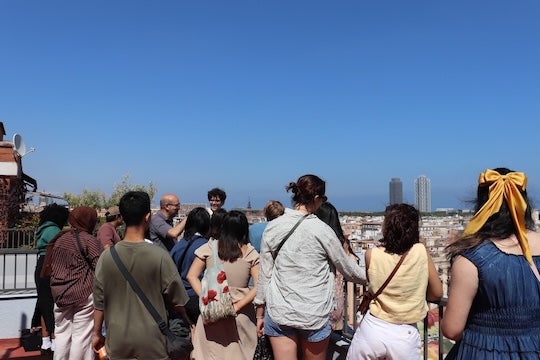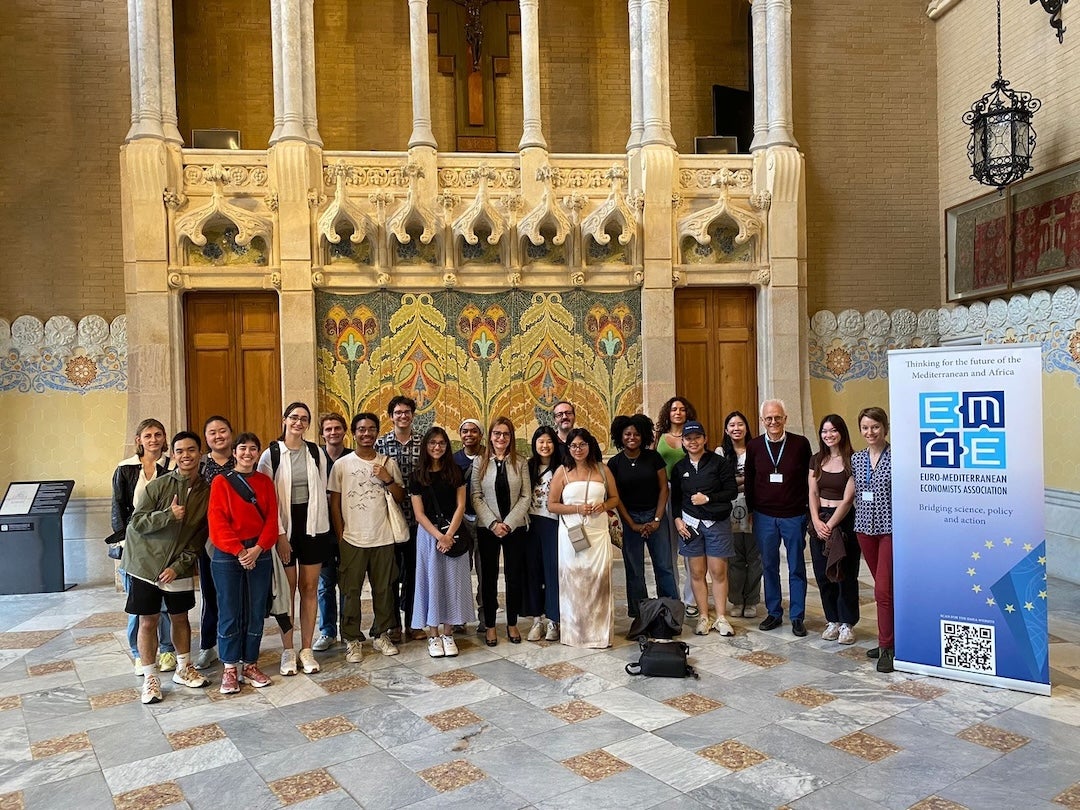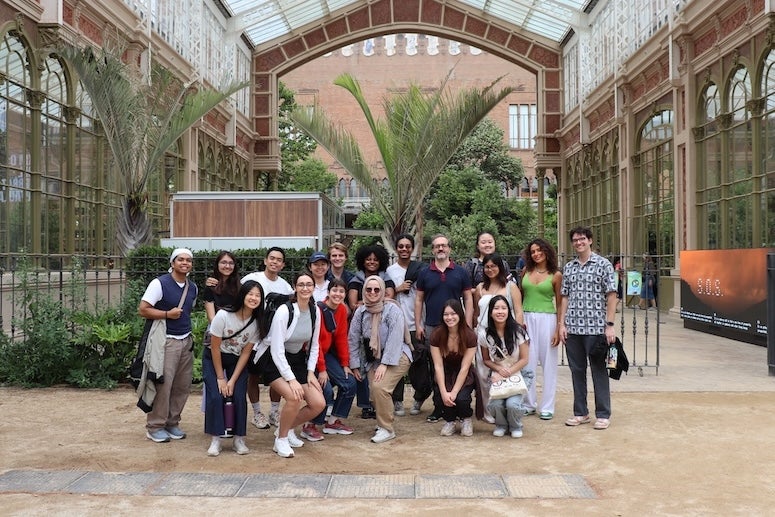
A group of students from Rice University’s School of Architecture and George R. Brown School of Engineering visited Barcelona, Spain, in June as part of a new initiative in the School of Architecture called Global Workshops. This new initiative allows faculty to bring students to various locations worldwide where they are conducting research or creative projects.
The inaugural cohort of 2024 Global Workshops included summer programs in Barcelona, led by Assistant Professor Juan José Castellón; Mexico City, led by Professor in the Practice Nathan Friedman; and Singapore, led by Assistant Professor Scott Colman. The Barcelona Global Workshop, titled “Building Ecologies: The Five Elements,” combined the disciplines and sought a greater understanding of sustainable design and infrastructure worldwide. The goal of such designs is to achieve resilient and adaptable communities that can better cope with the effects of climate change and extreme natural events while also understanding the role of current societies as part of a broader natural environment and planetary community.
“We are visiting places, meeting people, and trying to build a common platform for this interdisciplinary pedagogical experience, and the students are responding really well,” said Castellón, assistant professor of architecture and a 2024 Forge Prize finalist .
Partnering with the La Salle School of Architecture in Barcelona, the students visited various companies to learn about new materials, design and ecology and how these factors correlate with the city’s culture and tradition. This included visits to manufacturing companies, industrial, material and architectural heritage sites and urban infrastructures.

They were able to learn from hands-on construction of prototypes in collaboration with local manufacturers and experts in different disciplines followed by Rice faculty talks with Professor Qilin Li, who gave a lecture on water infrastructure, and Kalil Erazo, assistant teaching professor who spoke about the role of engineering and multidisciplinary collaboration in a contemporary scenario. Both Li and Erazo are from the Department of Civil and Environmental Engineering at Rice.
“We live at a time where civil infrastructure is not only expected to be resilient, sustainable and adaptable but also functional, aesthetically pleasant and convey a sense of emotion,” said Erazo, who worked with Castellón to make the engineering and architecture interdisciplinary workshop possible. “This requires a new multidisciplinary paradigm where professionals from different disciplines work as a team instead of independent entities that just exchange information.”
This intellectual exchange was completed with talks by invited guests from different disciplines and approaches.The students also attended workshop sessions to begin the process of developing a workshop booklet based on their experiences. They were divided into five teams — one for each element to be studied: shading, water, air, earth and ecology.

“Each day of the workshop offered a fresh perspective on architecture and engineering, leaving me confident in the vast opportunities that collaboration brings to the future of architecture,” said Alexis Winarske, a Master of Architecture student at Rice. “This global workshop was one of the most transformative educational experiences I’ve had at Rice and in higher education. Professor Castellón’s collaboration with Kalil Erazo created a truly special learning environment that has reshaped my vision for my future in architecture and beyond. I hope every student at Rice has the opportunity to experience this or something similar.”
“My trip to Barcelona was incredible,” said Connor Bird, a civil engineering student at Rice. “Prior to the trip, the most I knew about architecture was that they drew buildings that looked nice but were complicated to engineer. In a few of my classes, we had even talked about the occasional struggles between architects and engineers and the balance that has to be found in the real world. This balance was definitely found on the trip.
“Working with and exploring Barcelona alongside architects opened my eyes to the beauty of buildings and allowed me to understand the profession on a much deeper level.”
Castellón consulted with other faculty members like Harris Eyre, a fellow in brain health at the Center for Health and Biosciences at Rice’s Baker Institute for Public Policy, on designing a travel program that explored how architecture can combine ideas from different disciplines to achieve designs that are efficient in use of materials and contribute to a healthy environment.

“I think the students really appreciate having the chance to understand what they do in a broader context,” Castellón said. “They enjoy interacting with other students in the university, finding that they approach the same questions from completely different perspectives.”
“Approximately 40% of the total energy consumption of all sectors in the United States is attributed to residential and commercial buildings with roughly 25% from embodied carbon and 75% from operation,” Erazo said. “This implies that engineers and architects can have a considerable impact to achieve the sustainability goals that are urgently needed. It is also clear that a multidisciplinary perspective is needed with new efficient materials that can reduce the infrastructure embodied carbon and novel architectural designs that allow optimizing the use of light, water and air to minimize operation emissions. This multidisciplinary perspective was the foundation of the Building Ecologies workshop.”
Erazo used an example of a workshop where the students developed strategies to understand what sustainable design looks like for an engineer and an architect before collectively discussing and finding strategies.
“They would have never reached the same result if they would have analyzed things with only the students from engineering or architecture,” Castellón said. “When they were together, they were enriching the conversation with their different perspectives and learning from each other, so it’s a much richer kind of academic exchange and more holistic.”
Castellón said he looks forward to finding more ways to utilize this cross-disciplinary learning process with more students in the future.
“My students that are now in the workshop are asking, ‘How could we do more of this?’” he said. “We want this not to be an exception but something that happens more often.”
“We hope that the workshop strengthens multidisciplinary collaborations at Rice,” Erazo said. “The students’ experience was very positive, and they are now eager to work with students from other disciplines to solve the challenges of their generation.”
Besides the support of the architecture and engineering departments at Rice, the workshop was also selected to receive funding from the Conference and Workshop Development Fund.
“I am grateful to professors Castellón, Erazo, and Li for their collaborative work that has made one of our first Global Workshops such a success,” said Igor Marjanović, William Ward Watkin Dean of Rice Architecture, “This new program will continue in the future, providing important educational enrichment to our students, all while exposing them to faculty research projects around the world.”


